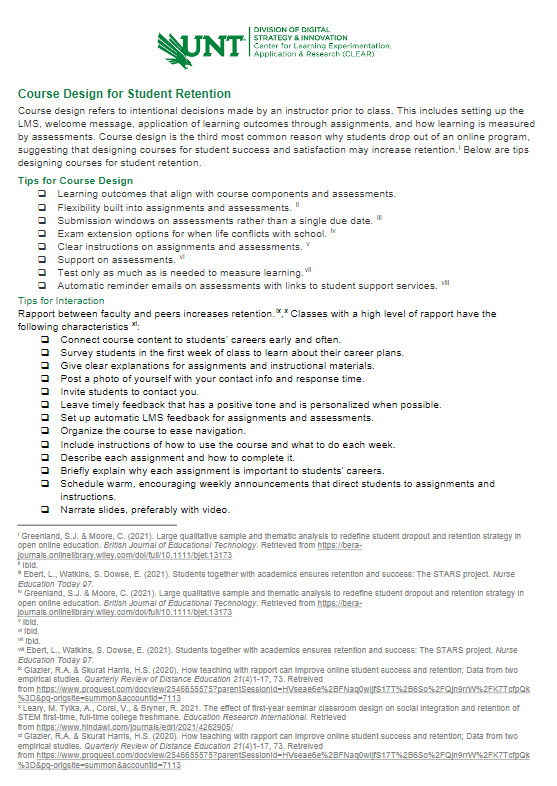- DSI CLEAR
- Teaching Resources
- Theory & Practice
- Methods for Continuous Improvement
- Using AI in the Higher Education Classroom
- Invisible Labor and Faculty Retention Since COVID-19
- Inclusive Discussions
- Inclusive Assessment
- Designing Assessments for Academic Integrity
- Inclusive Instructional Strategies
- Instructor Presence in the Online Classroom
- Tips for Providing Personalized Feedback to Students
- Course Design for Student Retention
- UNT's CLAW 3 Active Learning Classroom Instructional Guide
- UNT Faculty Teaching & Learning Resource Guide
- Growth Mindset in the Higher Education Classroom
- Course Outcomes & Objectives
- Multimedia Course Design for Student Engagement and Retention
- Level Up Learning With Portfolios
- Group Work in Higher Education: Benefits & Practices for Success
- Open Educational Resources & Copyright Essentials for Instructors
- Evaluating OER Resources
- Accessibility Online
- Copyright Guide
- Online Teaching
- UNT Syllabus Template
- Teaching Consultation Request
- Open Educational Resources & Copyright Essentials for Instructors
- Evaluating OER Resources
Course Design for Student Retention

Due to the longitudinal nature of research on student retention, the literature on strategies for retaining university students during the COVID-19 pandemic is still developing. Additionally, in spring 2020 many universities made special accommodations to account for rapid changes brought on by COVID-19, including shifting teaching modalities and extended breaks in learning. One such example involves an Appalachian R1 that reported higher retention rates in 2020. Students on academic probation and at risk of suspension were allowed to remain enrolled due to COVID-related, campus-wide accommodations (Leary et.al, 2021).
Based on trends in the literature, there is a relationship between instructional practice and student retention. In a recent study, course design was found to be the third most common reason why students dropped out of an open online education program (Greenland & Moore, 2021). In a study on retention of community college students, student satisfaction with courses was a predictor of successful completion (Armstrong et.al, 2020). This suggests that designing courses for student success and satisfaction may increase retention. Considering how little we know about the long-term impact of COVID-19 on the retention of university students, it is imperative to review the available literature.
Course Design
Course design refers to intentional decisions made by an instructor before the first day of class such as the look and feel of the LMS, the welcome message, the application of learning outcomes through assignments, and how learning is measured by assessments. In a qualitative study of 200 students who dropped out of online classes, one of the most common reasons given for dropping out was module content and design (Greenland & Moore, 2021). This included flexibility of assignments and assessments as well as user-friendliness of the LMS. Students also expressed a need for more exam extension options that allowed for personal conflicts with school, as well as an option for alternative assessments and flexible deadlines (Greenland & Moore, 2021). Participants also stated the need for clearer instruction and support on assessments and urged instructors not to over test (Greenland & Moore, 2021).
A study on calculus courses by Golnabi, Murray, & Su (2021) found that course design that included alignment between learning objectives, course components, and assessment positively impacted student performance. Similarly, assignment submission windows and automatic reminder emails including links to student support services helped retain Australian midwifery students (Ebert et.al, 2021).
Course design practices associated with student retention are summarized below.
- Flexibility built into assignments and assessments
- Submission windows on assessments rather than a single due date
- Exam extension options in case life conflicts with school
- Clear instructions on assignments and assessments
- Support on assessments
- Test only as much as is needed to measure learning
- Learning outcomes that align with course components and assessments
- Automatic reminder emails on assessments with links to student support services
Interaction
The relationship between interaction and student retention is prevalent in the literature. When faculty establish rapport and positive relationships with students, retention rates increase (Glazier & Skurat Harris, 2020). While interaction and relationships are often not graded components in the way that course activities and assessments are, given the recurrence in the literature of the impact of interaction on student retention, time spent planning them into the semester is warranted.
It is not only interaction between student and instructor that positively affects retention. A study by Leary et al (2021), found that classroom design that encouraged peer interaction in the first year and helped students build social networks and improved university-level retention into the second semester. The same study found that flipped classrooms in which content is read or watched before class meetings led to higher retention than courses that were not flipped (Leary et al., 2021). When a course is flipped, it leaves class time open for interactive activities in which the learning objectives are applied.
A study conducted by Glazier & Skurat Harris (2020) explored the impact of “minimal rapport” in an online course. The minimal rapport class was clearly organized, made connections to student careers, gave clear instructions for all materials, communicated that the instructor was available and approachable, and included quick instructor response time. These rapport features were implemented for the first week only to test minimal rapport. All minimal rapport measures were asynchronous and automated; there was no instructor interacting with students synchronously. The findings of this study were that students are significantly more likely to stay in class with minimal rapport than with no rapport (Glazier & Skurat Harris, 2020).
Glazier & Skurat Harris (2020) also conducted a “high rapport” class experiment which increased the class pass rate by as much as 25%, especially for students with low GPAs. High rapport classes include the following practices (Glazier & Skurat Harris, 2020):
- Connect course content to students’ careers early and often.
- Survey students in the first week of class to learn about their career plans.
- Give clear explanations for assignments and instructional materials.
- Post a photo of yourself with your contact info and response time.
- Invite students to contact you.
- Leave timely feedback that has a positive tone.
- Set up automatic LMS feedback for assignments and assessments.
- Leave personalized feedback when possible.
- Organize the course to ease navigation.
- Include instructions of how to use the course and what to do each week.
- Describe each assignment and how to complete it
- Briefly explain why each assignment is important to students’ careers.
- Schedule warm, encouraging weekly announcements that direct students to weekly assignments and instructions.
- Narrate slides, preferably with video.
Course design and intentional interaction are small changes that faculty can make in online courses and even in online shells for in-person courses. DSI CLEAR’s faculty development team invites you to try these evidence-based practices and let us know how they work in your UNT classes.
References
Armstrong, V.O., Tudor, T.R., Hughes, G.D. (2021). Course retention in community colleges: Demographics, Motivation, Learning Style, and Locus of Control. American Journal of Distance Education 35(1)
Ebert, L., Watkins, S. Dowse, E. (2021). Students together with academics ensures retention and success: The STARS project. Nurse Education Today 97.
Glazier, R.A. & Skurat Harris, H.S. (2020). How teaching with rapport can improve online student success and retention; Data from two empirical studies. Quarterly Review of Distance Education 21(4)1-17, 73. Retrieved from https://www.proquest.com/docview/2546655575?parentSessionId=HVseae6e%2BFNaq0wIjfS17T%2B6So%2FQjn9rrW%2FK7TcfpQk%3D&pq-origsite=summon&accountid=7113
Golnabi, A.H., Murray, E., Su, H. 2021. How precalculus course coordination can impact students’ academic performance. Journal of Higher Education Theory and Practice 21(5) 175-185. Retrieved from https://www.proquest.com/docview/2556885595?parentSessionId=yHjZEnqdJozKSh1F7pBwAKreN1sjO874iwJxVBRkNos%3D&pq-origsite=summon&accountid=7113
Greenland, S.J. & Moore, C. (2021). Large qualitative sample and thematic analysis to redefine student dropout and retention strategy in open online education. British Journal of Educational Technology. Retrieved from https://bera-journals.onlinelibrary.wiley.com/doi/full/10.1111/bjet.13173
Leary, M. Tylka, A., Corsi, V., & Bryner, R. 2021. The effect of first-year seminar classroom design on social integration and retention of STEM first-time, full-time college freshmen. Education Research International. Retrieved from https://www.hindawi.com/journals/edri/2021/4262905/
